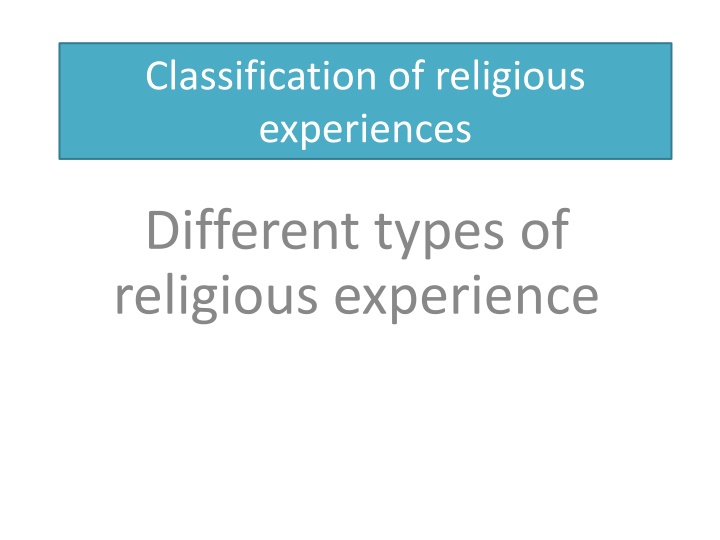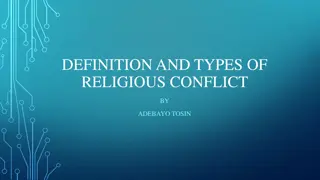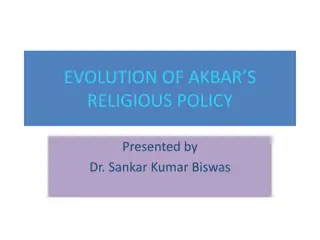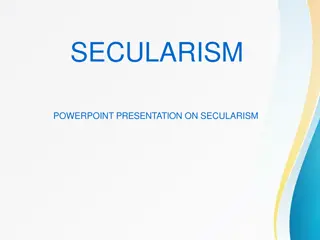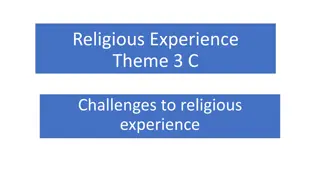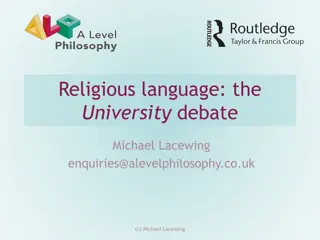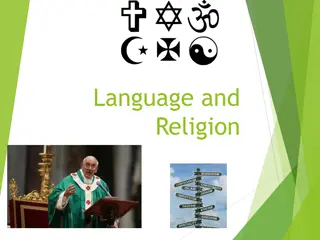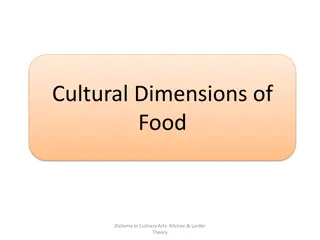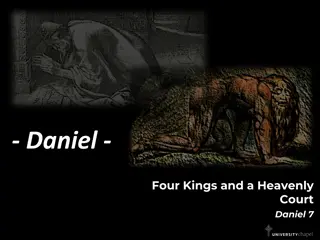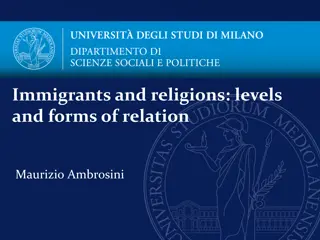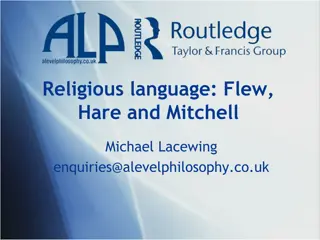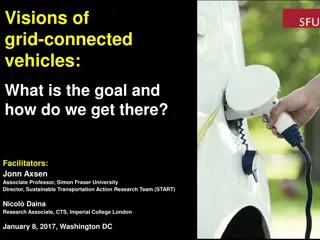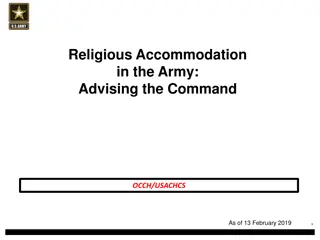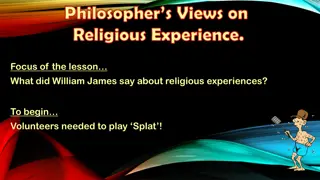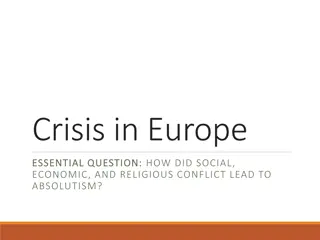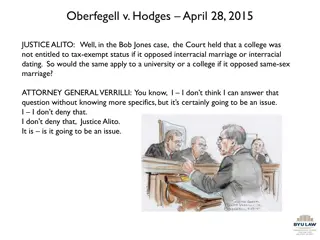Study of Different Types of Religious Experiences and Visions
This content discusses the classification and nature of religious experiences, focusing on visions, conversion, mysticism, and prayer. Various forms of visions, including sensory, intellectual, and dreams, are explored along with examples such as Joan of Arc. The different types of visions are detailed, from sensory to imaginative and intellectual, experienced both individually and collectively in religious contexts.
Download Presentation

Please find below an Image/Link to download the presentation.
The content on the website is provided AS IS for your information and personal use only. It may not be sold, licensed, or shared on other websites without obtaining consent from the author.If you encounter any issues during the download, it is possible that the publisher has removed the file from their server.
You are allowed to download the files provided on this website for personal or commercial use, subject to the condition that they are used lawfully. All files are the property of their respective owners.
The content on the website is provided AS IS for your information and personal use only. It may not be sold, licensed, or shared on other websites without obtaining consent from the author.
E N D
Presentation Transcript
Classification of religious experiences Different types of religious experience
This first section is designed to introduce candidates to the nature of religious experience by referring to various forms of religious experience. Each of the four stated forms: visions; conversion; mysticism and prayer should be studied in the light of religious traditions which can exemplify each of these. Centres will find reference to Teresa's types of prayer, as explained in The Interior Castle, useful to refer to. Similarly, centres should refer to Teresa's description of the stages of prayer as explained in the Garden analogy. In each case, (i.e. types and stages) candidates will be expected to be familiar with both of her analogous explanations and be able to give a brief description of each. Centres may focus on one tradition (e.g. Islam) for exemplification of all four forms, although it is equally permissible to draw on examples from several different religious traditions if that is deemed preferable.
The nature of religious experience with particular reference to: D Visions sensory; intellectual; dreams. Conversion individual/communal; sudden/gradual. Mysticism transcendent; ecstatic and unitive. Prayer types and stages of prayer according to Teresa of Avila.
Visions Definitions - sensory; intellectual; dreams. Examples Joan of Ark's vision Joan of Arc song
Definition: Something seen other than by ordinary sight Usually believed to come from a deity i.e. God, Jesus or the Virgin Mary Conveys a message or revelation of some sort
Different types of vision Sensory/ Corporeal visions- where the object is external and conveys knowledge and understanding to the recipient and is only visible to certain people Dreams/ Imaginative visions- where the image is produced in the persons imagination, the unconscious state where knowledge or understanding is gained through a series of images or a dream- narrative i.e. it is internal Intellectual visions brings knowledge and understanding such as revelation from God Also Group visions- seen by more than one person Individual visions- seen only by one person
Sensory visions Group visions Individual visions Corporeal visions Seen by more than one person. Angel of Mons First World War British soldiers saw a vision of St George and a phantom bowman Seen by only one person E.g. Bernadette next slide Of a material nature, physical
Content of visions Religious figures- St Teresa of Avila s vision of an angel holding a long spear that seemed to pierce her heart several times and when it was withdrawn it left her completely afire with a great love for God , St Bernadette Places (heaven & hell) Guru Nanak s vision of God s court Fantastic creatures / figuresEzekiel s vision of four living creatures The future John s visions in the book of Revelation that describes the dead being judged.
An example of a famous vision: Lourdes: is one of the most visited places (pilgrimages) in the world, by Catholics. Read the information on pages 6-7. Complete Task 3
Consolidation Find and read Genesis 28: 10-22 What type of vision?
Examples There are three ways an individual can experience a vision: 14 year old St Bernadette of Lourdes visions of The Immaculate Conception who told her to build a temple of the ground of Lourdes because the spring water had healing powers (temple at Lourdes) Intellectual vision (brings about knowledge and understanding such as a revelation from God) Julian of Norwich 14-15th century mystic had visions I looked at it thoughtfully and thought, what is this? and the answer came, It is all that is made . Imaginary/Dream vision (internal - something that strengthens faith is seen with the mind s eye such as Jacob s vision of a ladder to heaven in Genesis 28) The purpose of visions Sensory/Corporeal vision (the figure is externally present such as St Bernadette s vision of the Virgin Mary) Visions A religious vision occurs when an individual believes to have seen or heard something supernatural or a supernatural being.
Conversion Definitions Conversion means to change direction or to turn around . It is a process of change that alters one s view of the world and one s personal place in it. St Paul's conversion Cat Stevens conversion to Islam Scholars to research William James Moojan Momen Lofland and Stark
Types of conversion Can convert from one religion to another Can convert to a religion when previously had no faith - Augustine is an example of a moral conversion, in that his wayward life was challenged when he read the words from Romans, which exhorts the reader to abandon the works of the flesh and be clothed with Christ. Can convert from believing to trusting - John Wesley s vivid experience that enlivened his faith. He wrote: I felt my heart strangely warmed, I felt I did trust Christ, Christ alone, for salvation; and an assurance was given me, that he had taken away my sins
Types of conversion Individual Communal The conversion is of a group of people at the same occasion The first Pentecost in Acts of the Apostles 2:1 21 (New Testament). The conversion is of a single person rather than a group Paul s conversion, when he saw blinding light and heard the voice of Jesus calling him to ministry. His life was changed forever.
PASSIVE The conversion is not deliberately sought but comes upon them unexpectedly. ACTIVE The conversion is deliberately sought, perhaps by going to an evangelistic meeting with the intention of responding to the preacher SUDDEN The conversion takes place suddenly, when a clear decision is made and a particular date can be given for the event. However, there may have been prior sub-conscious development. GRADUAL The conversion takes place over a length of time possibly even years
Features of a conversion: (Volitional type more likely to have permanent effects than self-surrender because the gradual process causes objections to be resolved and often leads to some of the most passionate and fundamentalist advocates of a given religious group) Two things in the mind of a candidate for a conversion: Types of conversions: Volitional type a conscious and voluntary experience (features a gradual change and consists of the slow development of new moral and spiritual habits the individual suddenly becomes aware of the change one day) The present wrongness in their life their sins perhaps and that they want to change The positive changes they wish to make Self-surrender type an involuntary and unconscious experience, often sudden (the subconscious effects are more evident William James: Man s extremity is God s opportunity ) Often affects people who had no religious faith whatsoever before the religious Intellectual conversions conflicts between 2 systems of thought, with the new one often resulting as being true and the old one false William James volitional type requires some element of surrender Edwin D. Starbuck quite often a person must stop trying to change ; only then will conversion occur naturally Moral conversions conflicting lifestyles, with the new one often resulting as true and the old one as false Conversions Religious experiences are considered to be conversions if their effects on the subject are life-changing. The term conversion refers directly to the regeneration of the individual s life and is an assurance of the truth of the Divine . The result of a conversion on a personal level is usually a greater understanding of faith, and often leads to the adoption of a religious attitude or way of life and these effects can be permanent or temporary.
Mysticism A mystical experience is one in which the subject becomes overwhelmingly aware of the presence of God Mystical experiences have several common features: A sense of union with the divine. A sense of dependence on God. A sense of separateness from God. Time is transcended. Noetic experiences (William James) or a showing (Mother Julian of Norwich) something is clearly revealed to the person receiving the experience. A sense of joy and well-being
Paul Tillich described two stages in a mystical experience: The first is an event or encounter. The second is a special understanding of that event as the result of ecstasy, a special way of looking at the event which reveals its religious significance.
The nature of mystical experiences Nature - The experience of oneness with nature. God is everywhere so he can be experienced through the natural world Monistic - The experience of one s own spirit as the Absolute, the identity of Atman and Brahman. Theistic - Union or communion with a personal Lord. In which the mystic looks inwards on her own experience and understands her own oneness with the divine
Transcendent; ecstatic and unitive. Ed Miller created a summary of mystical experiences Transcendent: not localisable in space or time, takes the experient beyond the realm of normal everyday experience e.g. other worldly Ecstatic: filling the soul with bliss and the closest mortal souls can get to the presence of God Unitive: uniting the soul with reality, removal of the separation between the individual and God Plus Ineffable: not expressible in language Noetic: conveying illumination, truth, new knowledge
William James Four Characteristics of mystical experience: Features of a mystical experience: Types of mysticism (F.C. Happold provided suggested we can divide mysticism for convenience Knowledge of the ultimate reality is gained which is knowledge usually hidden from the human intellect 1. Ineffability indescribable (St Teresa of Avila: I wish I could give a description of at least the smallest part of what I learned but, when I try to discover a way of doing so, I find it impossible ) A sense of freedom from the limitations of time, space and the human ego is experienced The mysticism of love and union (the longing to escape from loneliness and being separate driven by the desire for separation and to be part of something bigger than ourselves. We are trying to get back to God hence the desire to be part of something bigger than ourselves) A sense of oneness or unity with the Divine is experienced 2. Noetic quality Knowledge is grasped through intuition and perception and therefore brings intuitive understanding and realisation of the truth A sense of bliss or serenity is experienced 3. Transiency Most religious experiences last between a few minutes and about 2 hours and may be difficult to remember, but stay forever rich in authoritative for the subject The mysticism of knowledge and understanding (We need to try to find out the secret of the universe and we do not seek this in sections but in the whole story . The way that we can look for answers to such an ultimate question is through experiential knowledge of God) 4. Passivity during the experience, the subject loses control to a more powerful being causing the individual to assume entirely different personalities, or speaking in a completely different voice or language (without conscious control) Mystical experience Mystical experiences are experiences where the recipient feels a sense of union with the divine, involving the spiritual recognition of truths beyond normal understanding.
Lesson 2 Starter Complete the sections on Visions, Conversions and Mysticism on the mindmap from memory
Definition Different types of visions with examples Different types of conversions with examples Definition Individual Communal Conversion Visions Characteristic features of conversion James No faith to faith Content of visions One faith to another Believing to trusting Sudden Gradual Volitional or self- surrendering 3 A Nature of Religious experience Nature of mystical experiences Transcendent Passive or active St Teresa of Avila Interior Castle Transforming 1 start to seek God Ecstatic 2 Practice of daily prayer Types of prayer 3 Exemplary life Blessing 4 Prayer of quiet Unitive Adoration 5 Preparation for God Prayer Petition 6 Revelation Mysticism Asking forgiveness 7 - United Intercession Thanksgiving Definition St Teresa of Avila Garden Analogy Praise
Prayer In a sense all religious experience is about prayer i.e. communion with God.
Types of Prayer Blessing - Ephesians 1:3 Adoration - Psalm 95.6 Petition - Colossians 4:12 Asking forgiveness - Luke 18:13 Intercession - 1 Timothy 2:1 Thanksgiving - 1 Thessalonians 5:18 Praise - Ephesians 3:20
Types of Prayer Fill in the type Bible references 1. 1. Come, let us bow down in worship, let us kneel before the LORD our Maker ; I urge, then, first of all, that petitions, prayers, intercession and thanksgiving be made for all people Epaphras, who is one of you and a servant of Christ Jesus, sends greetings. He is always wrestling in prayer for you, that you may stand firm in all the will of God, mature and fully assured Praise be to the God and Father of our Lord Jesus Christ, who has blessed us in the heavenly realms with every spiritual blessing in Christ. Blessing Now to him who is able to do immeasurably more than all we ask or imagine, according to his power that is at work within us, But the tax collector stood at a distance. He would not even look up to heaven, but beat his breast and said, God, have mercy on me, a sinner. give thanks in all circumstances; for this is God s will for you in Christ Jesus. 2. 2. 3. 3. 4. 4. 5. 5. 6. 6. 7. 7.
Types of Prayer Bible references Fill in the type 1.Adoration 1. Come, let us bow down in worship, let us kneel before the LORD our Maker ; Adoration 2. I urge, then, first of all, that petitions, prayers, intercession and thanksgiving be made for all people intercession 3. . Epaphras, who is one of you and a servant of Christ Jesus, sends greetings. He is always wrestling in prayer for you, that you may stand firm in all the will of God, mature and fully assured . Petition 4. Praise be to the God and Father of our Lord Jesus Christ, who has blessed us in the heavenly realms with every spiritual blessing in Christ. Blessing 5. Now to him who is able to do immeasurably more than all we ask or imagine, according to his power that is at work within us, Praise 6. But the tax collector stood at a distance. He would not even look up to heaven, but beat his breast and said, God, have mercy on me, a sinner. Asking forgiveness 7. give thanks in all circumstances; for this is God s will for you in Christ Jesus. Thanksgiving 2. Intercession 3. Petition 4. Blessing 5. Praise 6. Asking forgiving 7. Thanksgiving
St Teresa of Avila Scholars teachings on prayer St. Teresa of Avila (1515-1582) was a Spanish mystic and Roman Catholic saint. She had several religious experiences during her life, and wrote about the importance of mystic prayer to religious life. Teresa believed that the purpose of life was union with God, which is also the purpose of prayer. Therefore, the purpose of life is union with God through prayer. She wrote of the seven types of prayer in her work, The Interior Castle, and the stages of prayer in the analogy of the garden.
The Garden Analogy The analogy is presented in the Autobiography of Teresa of Avila, and gives the metaphor of a garden; with the earth representing the soul and water being the understanding of grace. Teresa stated that a beginner must look on himself as one setting out to make a garden for His Lord s pleasure, on most unfruitful soil which abounds in weeds. His Majesty roots up the weeds and will put in good plants instead.
1. Withdraw minds from outside world, hard work. Have to wait for God to help us. 2. God helps us (like the pulley in a well). Less effort is required. We lose desire for earthly things. Contact with God. 3. God takes over the work and we are joyful. Almost complete union, but we are conscious of the rapture. 4. We make no effort. Complete and perfect union with God. We can t consciously analyse our experience. This stage is brief. Iron example. Four stages 1. First Water (mental prayer) 2. Drawing Water (prayer of quiet) 3. Irrigated Garden (imperfect union) 4. Rain (perfect union)
The Interior Castle This work describes the seven mansions or seven dwelling places that each represent a step towards unity with God. It is a guide for spiritual development through service and prayer. Initially, we are introduced to those outside the castle who are described as paralyzed and crippled by sin. This level represents those who are spiritually and morally bound by evil.
Interior Castle Seven Mansions - Analogy 1 Start to seek God, but . . . 2 Practice of daily prayer 3 Exemplary life, aversion to sin 4 Prayer of quiet, love God 5 Preparation for God, period of darkness, soul is certain 6 Revelation, spiritual betrothal, joy 7 United, spiritual marriage summary of the interior castle
Definition Different types of visions with examples Different types of conversions with examples Definition Individual Communal Conversion Visions Characteristic features of conversion James No faith to faith Content of visions One faith to another Believing to trusting Sudden Gradual Volitional or self- surrendering 3 A Nature of Religious experience Nature of mystical experiences Transcendent Passive or active St Teresa of Avila Interior Castle Transforming 1 start to seek God Ecstatic 2 Practice of daily prayer Types of prayer 3 Exemplary life Blessing 4 Prayer of quiet Unitive Adoration 5 Preparation for God Prayer Petition 6 Revelation Mysticism Asking forgiveness 7 - United Intercession Thanksgiving Definition St Teresa of Avila Garden Analogy Praise
